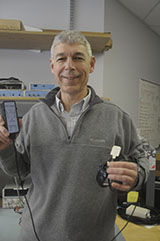


Posted February 20, 2014
Richard Hogle, Wicab, Inc, Middleton, WI
 It is estimated that 39 million individuals suffer from blindness worldwide, with incidence rates expected to double by the year 2020. Blindness may be caused by a variety of events including age-related vision loss or disease and traumatic injury (motor vehicle accidents, explosions, assault wounds, and combat-related blast injuries). The recent wars in Iraq and Afghanistan have produced an unprecedented number of service members who suffer from traumatic brain injuries and problems with their vision due to blast-related injuries. Sudden loss of vision is associated with substantial psychological and social consequences that can lead to severe depression and disability. Despite recent medical breakthroughs, few options exist to restore the perceptual abilities of individuals who are profoundly blind, especially those who are blinded by traumatic injury. To help address this issue, the Fiscal Year 2009 (FY09) Defense Medical Research and Development Program (DMRDP) awarded Richard Hogle of Wicab, Inc. an Applied Research and Advanced Technology award to develop a non-surgical aid to the visually impaired.
It is estimated that 39 million individuals suffer from blindness worldwide, with incidence rates expected to double by the year 2020. Blindness may be caused by a variety of events including age-related vision loss or disease and traumatic injury (motor vehicle accidents, explosions, assault wounds, and combat-related blast injuries). The recent wars in Iraq and Afghanistan have produced an unprecedented number of service members who suffer from traumatic brain injuries and problems with their vision due to blast-related injuries. Sudden loss of vision is associated with substantial psychological and social consequences that can lead to severe depression and disability. Despite recent medical breakthroughs, few options exist to restore the perceptual abilities of individuals who are profoundly blind, especially those who are blinded by traumatic injury. To help address this issue, the Fiscal Year 2009 (FY09) Defense Medical Research and Development Program (DMRDP) awarded Richard Hogle of Wicab, Inc. an Applied Research and Advanced Technology award to develop a non-surgical aid to the visually impaired.
Mr. Hogle led a team of interdisciplinary scientists at Wicab, University of Pittsburgh Medical Center, Lighthouse International, and Carnegie Mellon University to further develop the BrainPort V100 device. The V100 is a visual prosthetic that enables perception of visual information using the tongue and a camera system as a paired substitute for the eye. Visual information is collected from a video camera and translated into gentle electrical stimulation patterns on the surface of the tongue. The concept is similar to reading Braille with the fingertips. With training, users can perceive shape, size, location and motion of objects in their environment. This technology is intended to augment, and not replace, other assistive methods such as the white cane or guide dog.
In this award, blinded individuals used the device at home and provided feedback and performance data. Wicab, Lighthouse International and the University of Pittsburgh coordinated the human subject testing. Carnegie Mellon University led the software algorithm development and Wicab coordinated the entire effort, including hardware upgrades. As new feature improvements were implemented, user feedback and performance improvement were re-evaluated.
Mr. Hogle and the research team have been able to make enhancements to the device to improve the usability and reliability. Training materials have been developed and user feedback has guided software and hardware design to improve the user experience. The BrainPort V100 began as a bold concept and with these enhancements, it is now an accepted assistive tool for the blind. The device has been approved to carry the CE Mark as a medical device, and is commercially available in the European Union and Canada. It has also been submitted to the Food and Drug Administration for approval for use in the U.S.
With information gained from V100 users, the team has developed the next generation of the device, the BrainPort V200. The V200 not only includes improvements in functionality over the V100, but also improves the comfort and aesthetics of the device. The team believes these improvements will increase the overall social acceptance of the device and its chances of use for everyday activities.
With support from the DMRDP, this technology has seen vast improvement and has clearly demonstrated that the device can improve the performance of a blind individual in a number of activities including detecting objects, orientation, and mobility. Mr. Hogle and his team are developing solutions that will help improve the lives of not only wounded warriors, but the blind community as a whole.














